August 22-29, 2001
The Big Travelogue: Part Four
There's nothing like a good road trip to get a feel for the
state of radio these days. From June 23 until July 7, your editor
(accompanied by Boston Radio Archives creator Garrett Wollman)
hit the road to see what's on - and in - the air across a broad
swath of mid-America.
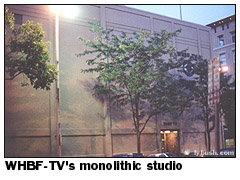 For
the next few installments of Site of the Week, we'll be recapping
the many highlights of what we like to think of as The Big Trip,
2001 edition. Come along... For
the next few installments of Site of the Week, we'll be recapping
the many highlights of what we like to think of as The Big Trip,
2001 edition. Come along...
Click
here for part one
Click
here for part two
Click
here for part three
Tuesday, June 26 - The sun is beginning to set as we
drive south on US 61 from Maquoketa and our quick stop at KMAQ
and KMAQ-FM, but we're trying to stay on schedule by seeing at
least a bit of Quad Cities radio and TV before dark. Crossing
the toll bridge from Davenport, Iowa into Rock Island, Illinois,
we make it to the big concrete tomb that encases CBS affiliate
WHBF-TV (Channel 4) just as it's getting really dark out. The
WHBF building is crowned by a big self-supporting tower that
apparently once held WHBF-TV's own transmitter, but now carries
only a public radio translator.
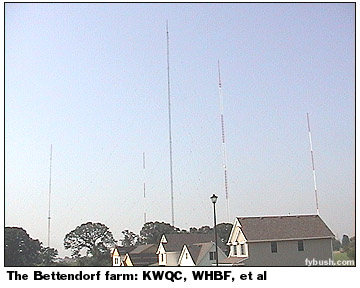 We check
into our hotel in Bettendorf, Iowa just in time to catch the
very end of the 9:00 news on Fox affiliate KLJB-TV (Channel 18),
which I'd somehow forgotten about, but with plenty of time to
set up the VCRs for all three 10 PM shows and to grab some dinner. We check
into our hotel in Bettendorf, Iowa just in time to catch the
very end of the 9:00 news on Fox affiliate KLJB-TV (Channel 18),
which I'd somehow forgotten about, but with plenty of time to
set up the VCRs for all three 10 PM shows and to grab some dinner.
Wednesday, June 27 - A very long day dawns with tape
rolling on the Quad Cities radio market and an early call to
begin our tower-hunting. First up is a site just a few miles
from our Bettendorf lodgings, the tower farm that began as the
transmitter site of WOC (1420), Davenport's oldest radio station.
WOC dates back to the early 1920s and the Palmer School of
Chiropractic, which remains alive and well on Brady Street in
downtown Davenport (more on that in a moment). In the eighty
or so years since, it's survived a shotgun marriage to Des Moines'
WHO (the two shared a frequency and a transmitter through much
of the thirties) and a series of owners. Today, it's Clear Channel's
news-talk outlet in the Quad Cities, and it's far from alone
at this transmitter site.
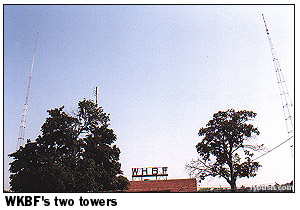 Who
else is here? For starters, the former WOC-TV, now KWQC (Channel
6) and the former WOC-FM, now WLLR-FM (103.7), accompanied by
WHBF-TV; public radio WVIK (90.3 Rock Island), and religious
WDLM-FM (89.3 East Moline), not to mention the DTV counterparts
of KWQC and WHBF-TV. I think it shakes out like this: WDLM-FM
is on the tower at the far left. WOC uses the three painted towers,
with the one in the center carrying the other FMs and the original
channels 4 and 6 antennas. The tall unpainted tower in the middle
is a newer tower carrying the TVs, I believe. Who
else is here? For starters, the former WOC-TV, now KWQC (Channel
6) and the former WOC-FM, now WLLR-FM (103.7), accompanied by
WHBF-TV; public radio WVIK (90.3 Rock Island), and religious
WDLM-FM (89.3 East Moline), not to mention the DTV counterparts
of KWQC and WHBF-TV. I think it shakes out like this: WDLM-FM
is on the tower at the far left. WOC uses the three painted towers,
with the one in the center carrying the other FMs and the original
channels 4 and 6 antennas. The tall unpainted tower in the middle
is a newer tower carrying the TVs, I believe.
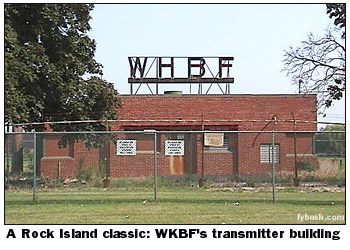 From
here, we head south into Illinois once more, this time to the
line that divides Rock Island from Moline. It's here, across
from a nursing home, that we find another old-time AM. From
here, we head south into Illinois once more, this time to the
line that divides Rock Island from Moline. It's here, across
from a nursing home, that we find another old-time AM.
The former WHBF (1270) is now WKBF, but Cumulus never changed
the calls on the transmitter building when it bought the station,
which now runs adult standards off the bird.
We note a group of engineers taking measurements around the
site while we're taking our pictures, so perhaps there's some
work to be done here. (And we wonder: is that another old WHBF-TV
antenna on the tower to the right of the building?)
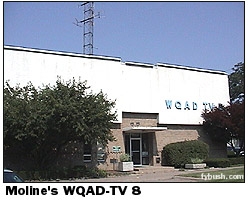 Heading
south towards the Quad Cities Airport, we pass the area's ABC
affiliate, WQAD-TV (Channel 8), licensed to Moline. The New
York Times owns this one...but it's a long way from
West 43rd Street in Manhattan to Park 16th Street in Moline... Heading
south towards the Quad Cities Airport, we pass the area's ABC
affiliate, WQAD-TV (Channel 8), licensed to Moline. The New
York Times owns this one...but it's a long way from
West 43rd Street in Manhattan to Park 16th Street in Moline...
(A final note on Quad Cities TV: Public TV in the market comes
from WQPT, Channel 24 in Moline, which maintains a second simulcast
transmitter at its Black Hawk College studios for KQCT, Channel
36.)
From WQAD we drove south for 20 miles or so on I-74 until
we reached the big Illinois-side cluster of TV and FM sites.
On US 150, just a mile or so east of I-74, a line of towers includes
WQAD itself, WQPT, WHTS (98.9 Rock Island, the old WHBF-FM) and
WXLP (96.9 Moline).
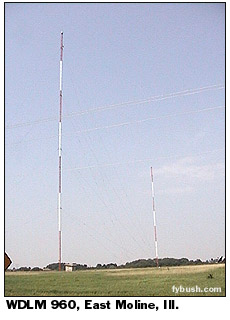 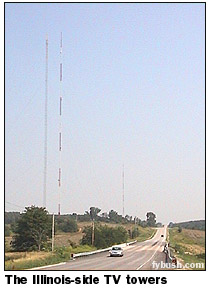 Not far away, off
the highway near the hamlet of Coal Valley, Illinois, we saw
the studio of religious WDLM (960 East Moline) and WDLM-FM (89.3
East Moline), sitting next to the two towers of AM 960. Not far away, off
the highway near the hamlet of Coal Valley, Illinois, we saw
the studio of religious WDLM (960 East Moline) and WDLM-FM (89.3
East Moline), sitting next to the two towers of AM 960.
Also near here, but not on our agenda, is the site of all-sports
KJOC (1170 Davenport), which was once KSTT and a major top-40
voice in this region, back when a highly-directional AM signal
could do that sort of thing.
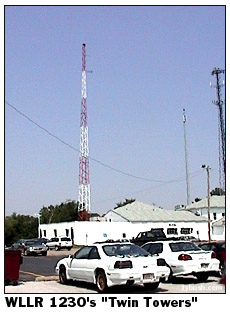 Returning to Rock
Island (through a lot of construction), we passed the site of
Moline-licensed 1230 AM. This station has been through a variety
of calls and formats, ending up a decade or so ago as WLLR(AM),
simulcasting the country format of WLLR-FM when it was on 101.3
Moline. Returning to Rock
Island (through a lot of construction), we passed the site of
Moline-licensed 1230 AM. This station has been through a variety
of calls and formats, ending up a decade or so ago as WLLR(AM),
simulcasting the country format of WLLR-FM when it was on 101.3
Moline.
The era of consolidation brought a frequency swap between
WLLR-FM and KUUL, the oldies station that had been on 103.7 in
Davenport (the old WOC-FM), and that in turn meant 1230
switched frequencies to simulcast, relaying WLLR-FM from its
new 103.7 home (and breaking away on weekends for NASCAR races!)
The tower sits behind this Elks party hall, which is called
"Twin Towers" in honor of the KUUL stick and the adjacent
cell tower. I guess they don't have too many other landmarks
in the area...
Passing through downtown Rock Island again, we crossed that
toll bridge once more to Davenport for a drive up Brady Street,
one of the main drags in town.
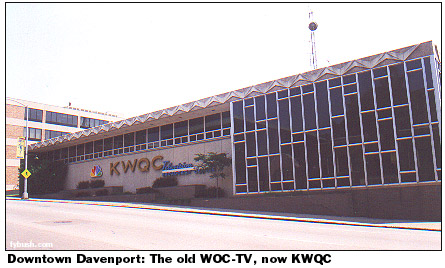 Across from the
Palmer College campus, this fifties-style building is still home
to KWQC-TV. I'd love to have seen it when that sign said "WOC"
back in the day, and when radio was in here as well. It's still
a nifty studio building, and quite safe from flooding in its
perch high on the slopes above the Mississippi (remember that
the blocks nearest the river suffered terrible flooding just
last year!) Across from the
Palmer College campus, this fifties-style building is still home
to KWQC-TV. I'd love to have seen it when that sign said "WOC"
back in the day, and when radio was in here as well. It's still
a nifty studio building, and quite safe from flooding in its
perch high on the slopes above the Mississippi (remember that
the blocks nearest the river suffered terrible flooding just
last year!)
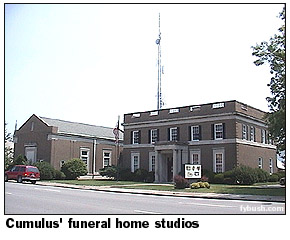 A few
blocks north on Brady is the Cumulus studio complex, which includes
KJOC, WXLP, KUUL, WLLR and Muscatine-licensed KBOB (99.7). A few
blocks north on Brady is the Cumulus studio complex, which includes
KJOC, WXLP, KUUL, WLLR and Muscatine-licensed KBOB (99.7).
If it looks a bit somber, there's a darned good reason: it
used to be a funeral home!
(Clear Channel, the other big group owner, has all its stations
in an office park somewhere near the highway in Bettendorf...)
Almost directly across the street from Cumulus, an office
building crowned with a self-supporting tower is apparently a
former 106.5 (KCQQ Davenport) transmitter site, now used for
an auxiliary transmitter and a noncommercial translator relaying
KUNI from the University of Northern Iowa in Cedar Falls.
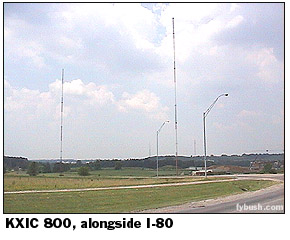 While our time in
the Quad Cities was finished, the day was far from done, as we
headed north to I-80 and then west an hour or so to the next
market on the schedule: Iowa City/Cedar Rapids/Waterloo. While our time in
the Quad Cities was finished, the day was far from done, as we
headed north to I-80 and then west an hour or so to the next
market on the schedule: Iowa City/Cedar Rapids/Waterloo.
It's easy to know when you've arrived in the market: right
next to the second Iowa City exit are these two towers, Clear
Channel news-talker KXIC 800. They were doing Cubs baseball when
we passed through, and we didn't hear anything legal-like at
the top of the hour, alas.
KXIC's studios are at the base of the towers, shared with
classic rocker KKRQ 100.7 ("The Fox.," serving Iowa
City and Cedar Rapids).
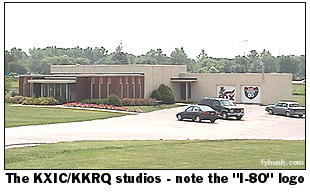 Check
out the KXIC logo on the building - if you had a station on AM
800 located right next to an I-80 offramp, you'd use that logo,
too! Check
out the KXIC logo on the building - if you had a station on AM
800 located right next to an I-80 offramp, you'd use that logo,
too!
We drove through the college town of Iowa City (the administration
building of the University of Iowa is the former Iowa territorial
capital!) listening to the student station, KRUI (89.7), and
a student jock who was just filling in during summer break, which
might explain why she was playing Japanese pop music and doing
her breaks in Japanese - not what you'd expect to hear on the
radio dial in Iowa at all!
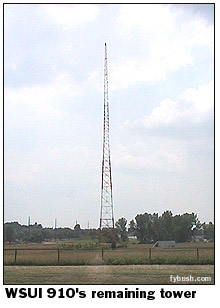 The University of
Iowa has two more radio services to offer. On FM, KSUI (91.7)
is a pretty standard public radio outlet, largely classical music
for an audience that stretches across most of eastern Iowa. On
AM, though, there's something special. WSUI (910) is one of a
handful of noncommercial AMs that date back to the 1920s, when
many midwestern land-grant schools obtained radio licenses and
then fought to maintain them in the face of the big commercial
interests. The University of
Iowa has two more radio services to offer. On FM, KSUI (91.7)
is a pretty standard public radio outlet, largely classical music
for an audience that stretches across most of eastern Iowa. On
AM, though, there's something special. WSUI (910) is one of a
handful of noncommercial AMs that date back to the 1920s, when
many midwestern land-grant schools obtained radio licenses and
then fought to maintain them in the face of the big commercial
interests.
Many of those signals ended up being relegated to daytime-only
status, and WSUI was no exception. It eventually won some night
service from a three-tower array, but its big signal is the daytime
non-DA 5 kW. In fact, the whole station has been non-directional
since a storm a few years ago that took out two of WSUI's three
towers. Shown at right is the remaining tower, which is apparently
being used at low power at night on special temporary authority.
WSUI has a CP to rebuild its old array, as well as a CP (likely
a typo) to recreate the old array 50 miles east in Bettendorf!
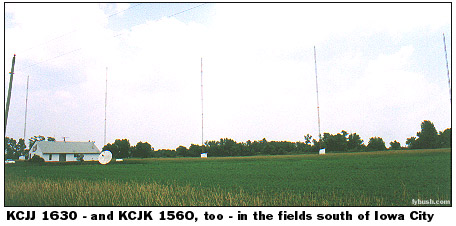 Keep driving south
of town and you'll come to a station that most Site of the Week
readers have probably heard. Keep driving south
of town and you'll come to a station that most Site of the Week
readers have probably heard.
KCJJ, which operated for years on 1560, was one of the very
first stations to move to the expanded band in the nineties,
and its new signal on 1630 kHz was, for a time, about the only
thing on the X-band to be heard on the East Coast. With a format
of 80s-heavy pop music, it quickly became a DX favorite, and
has remained so even as the band around it has become cluttered.
As for the old 1560, it went dark for a bit, then returned to
serve Iowans without X-band radios. It's now KCJK, though you'll
only find that out once an hour.
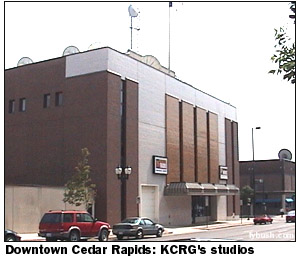 From
there, we stopped to tune in Iowa City TV (WB affiliate KWKB,
Channel 20, and Iowa Public TV's KIIN, Channel 12), then drove
north for half an hour on I-380 to Cedar Rapids. From
there, we stopped to tune in Iowa City TV (WB affiliate KWKB,
Channel 20, and Iowa Public TV's KIIN, Channel 12), then drove
north for half an hour on I-380 to Cedar Rapids.
After stops south of town at Kirkwood Community College, home
to jazz station KCCK 88.3, and the four-tower array of religious
KTOF 1360 (with former FM sister KHAK 98.1 still perched on one
tower), it was in to downtown for lunch and a studio.
Lunch was a Dairy Queen; the studio was KCRG-TV (Channel 9)
and sister all-sports station KCRG (1600), in this big brick
box. KCRG is the market's ABC affiliate, and the calls stand
for the Cedar Rapids Gazette, which still owns the stations.
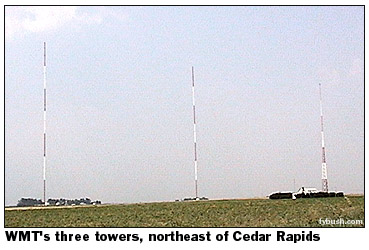 North
of town, outside the suburb of Marion, WMT (600) puts out a killer
signal from three very tall towers and a transmitter building
that looks like an old farmhouse. (Remember, we're getting into
the part of the country with really good ground conductivity,
so a 5 kW station low on the dial carries better by day than
many of the big 50 kW blowtorches on the coasts!) North
of town, outside the suburb of Marion, WMT (600) puts out a killer
signal from three very tall towers and a transmitter building
that looks like an old farmhouse. (Remember, we're getting into
the part of the country with really good ground conductivity,
so a 5 kW station low on the dial carries better by day than
many of the big 50 kW blowtorches on the coasts!)
We passed WMT's studios on the way up. Even though WMT and
WMT-FM (96.5) are now owned by Clear Channel and have long been
separate from WMT-TV (now KGAN, channel 2), all three stations
share a building on Old Marion Road, across from the huge Simmons
Rockwell plant. WMT-TV's old tower next to the building is now
used only as WMT-FM's transmitter site (and for STL and ENG purposes
by KGAN, the market's CBS affiliate).
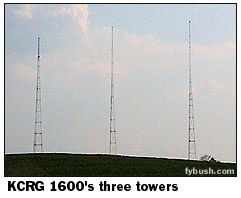 KCRG's
three towers are east of Cedar Rapids and south of Marion, just
east of US 151. Is that an old channel 9 antenna on one of the
towers? KCRG's
three towers are east of Cedar Rapids and south of Marion, just
east of US 151. Is that an old channel 9 antenna on one of the
towers?
Time constraints kept us from seeing the final AM in town:
KMRY (1450), a wonderful locally-owned adult standards outlet
that was a good listen for much of the afternoon, but there was
time to keep going north on I-380 (past the tower of CHR KZIA
102.9 and AC KDAT 104.5) to the tower farm up in Walker, halfway
between Cedar Rapids and Waterloo, some 30 miles to the northwest.
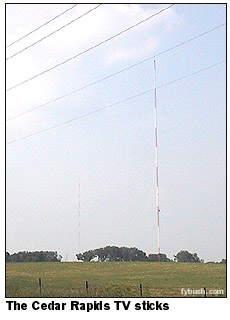 These
very tall towers are home to KGAN, KCRG-TV, Iowa Public TV's
KRIN (Channel 32) and Pax outlet KPXR (Channel 48), as well as
public radio KUNI (90.9 Cedar Falls); a few miles north (and
beyond our range this day) is Waterloo-licensed KWWL, the NBC
affiliate on channel 7. Its tower is also home to Waterloo FM
KFMW (107.9), which we're told has 16 bays at 1850 feet up on
the tower. Wow... These
very tall towers are home to KGAN, KCRG-TV, Iowa Public TV's
KRIN (Channel 32) and Pax outlet KPXR (Channel 48), as well as
public radio KUNI (90.9 Cedar Falls); a few miles north (and
beyond our range this day) is Waterloo-licensed KWWL, the NBC
affiliate on channel 7. Its tower is also home to Waterloo FM
KFMW (107.9), which we're told has 16 bays at 1850 feet up on
the tower. Wow...
We didn't visit Waterloo itself, so we missed out on stations
like KWLO (1330) and KWOF (850, simulcasting with KTOF on 1360).
not to mention nearby Cedar Falls and X-bander KCNZ (1650, simulcasting
still with KDNZ 1250).
You say there's another AM in Waterloo? Well, of course -
but KXEL 1540 knew what it was doing when it built its transmitter
site six decades ago. In order to serve multiple markets (while
still protecting Bermuda!), KXEL put its two towers in Dysart,
Iowa, about 20 miles south of Waterloo and not much farther from
Cedar Rapids.
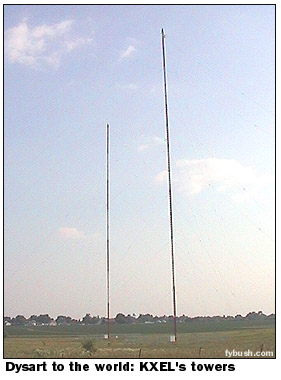 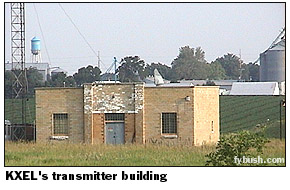
For such a potent signal, the site really isn't all that impressive
from the outside. The two towers are fairly short, as befits
a 1540 kHz station, and the building has clearly seen better
days.
Inside, we're told, is a veritable museum of old transmitters,
with a Westinghouse 50kW unit and an old Gates VB50 keeping the
current Harris DX50 company.
From Dysart, our early evening found us heading south towards
I-80, then west through Brooklyn, Grinnell and Newton to a sunset
stop at Iowa's most scenic transmitter site -- but that, and
the rest of Des Moines, is a story for Part Five, next Wednesday!
|
